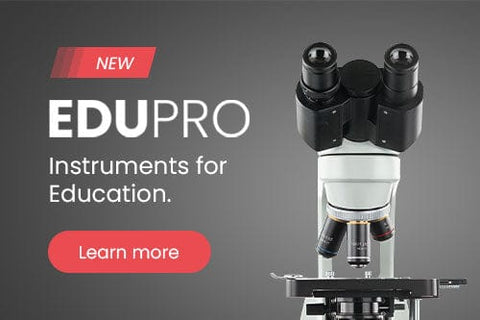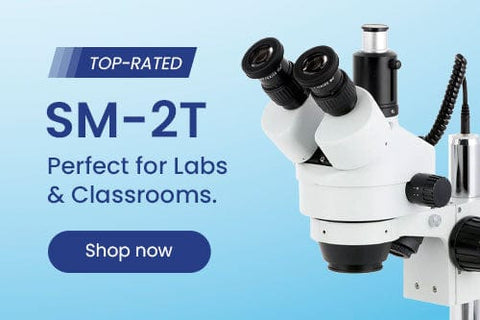- Microscopes
- Cameras
- Lab Supplies & Equipment
- Shop By Brand
- Lab Supplies by Category
- Analyzer Consumables
- Balances
- Bags
- Beakers
- Bench Scale Bases
- Bottles
- Bottletop Burettes
- Bottletop Dispensers
- Boxes
- Blank Microscope Slides & Cover Slips
- Blood Collection
- Caps
- Carboys
- Centrifuges
- Centrifuge Tubes
- Cold Storage
- Containers
- Cryogenic Vials
- Culture Tubes
- Cylinders
- Dispensers
- Digital Dry-Baths
- ESR Products
- False Bottom Tubes
- Flat Bottom
- Funnels
- Gel Documentation
- Glassware
- Glass Test Tubes
- Histology
- Homogenizers
- Hotplates-Stirrers
- Inoculation Loops and Spreaders
- Liquid Handling Products
- Manual-Electronic Pipettors-Pipettes
- Microscope Slides
- Overhead Stirrers
- Pipette Controller (Serological Filller)
- Pipette Tips
- Plastic Test Tubes
- PCR Tubes, Strips & Plates
- Racks
- Repeater Pipettor
- Rockers
- Rotary Evaporators
- Serological Pipettes
- Shakers
- Spectrophotometers
- Syringe Tips
- Sample Tubes
- School/Classroom Supplies
- Screwcap Test Tubes
- Self-Standing
- Test Tube Racks
- Test Tubes & Vials
- Transport & Storage Tubes
- Thermal Mixers
- Transfer Pipets
- Urinalysis
- Vacuum Pumps
- Weighing Dishes
- Lab Equipment
- Balances
- Bench Scale Bases
- Centrifuges
- Digital Dry-Baths
- Gel Documentation
- Homogenizers
- Hotplates-Stirrers
- Overhead Stirrers
- Pipettors
- Rockers
- Rotary Evaporators
- Shakers
- Serological Pipettes
- Spectrophotometers
- Thermal Mixers
- Vacuum Pumps
- Liquid Handling Products
- Manual-Electronic Pipettors-Pipettes
- Pipette Tips
- Racks
- Pipette Fillers-Controllers
- Repeater Pipettor
- Syringe Tips

Cost effective products and solutions designed to improve laboratory efficiency, safety and results.
SHOP BENCHMARK SCIENTIFIC >
- Slides & Accessories
- Slides
- Cameras
- Illuminators
- Adapters
- Eyepieces / Objectives
- Bulbs
- Magnifying Lamps
- Monitors and Tablets
- View All Categories
- Adapters
- DSLR Adapters
- USB Camera Adapters
- Ring Light Adapters
- Power Adapters
- Barlow Lens
- Books & Experiments Cards
- Bags & Cases
- Bags
- Cases
- Cameras
- Circuit Board Holders
- Cleaning Kits
- Condensers
- Darkfield
- Phase Contrast Kits
- Polarizing Kits
- Dust Covers
- Eye-Guards
- Eyepieces
- 20mm
- 23mm
- 30mm
- 30.5mm
- Filters
- Microscope Filters
- Illuminator Filters
- Fluorescence Kits
- Conversion Kits
- Filter Cubes
- Focusing Racks
- Fuses
- Illuminators
- Bulbs
- LED Illuminators
- Fiber Optic Illuminators
- Fluorescent Illuminators
- Ring Lights
- Stand Lights
- Goosenecks
- Gooseneck Attachments
- Immersion Oils
- Loupes
- Magnifying Lamps
- Clamp Lamps
- Desktop Lamps
- Rolling Stand Lamps
- Mechanical Stages
- Monitors and Tablets
- Calibration Slides & Stage Micrometers
- Stage Warmers
- Stain Kits
- Stands
- Articulating Arm Stands
- Boom Stands
- Table Stands
- Tweezers
- Other Accessories
- Shop By Industry
- Shop By Industry
- Botany
- Agronomy & Forestry
- Horticulture
- Phytopathology
- Chemistry
- Biochemistry
- Biotechnology
- Cannabis
- Pharmaceutics
- Consumables
- Beer & Wine
- Cosmetics
- Food & Beverage
- Electronics
- Circuit Boards & General Electronics
- Mobile Phone Repair
- Semiconductors & Wafers
- Environmental
- Asbestos
- Ecosystem Research
- Mud Logging
- Soil Treatment
- Water Treatment
- Forensics
- Ballistics
- Fingerprint Analysis
- Genetic Identification
- Hair & Fiber Analysis
- Handwriting Analysis
- Industrial
- Aerospace
- Automotive
- Dental Lab & Production
- Glass Industry
- Industrial Inspection
- Mechanical Parts
- Paper Industry
- Petrochemical
- Plastics
- Printing Industry
- Quality Assurance & Failure Analysis
- Textiles & Fibers
- Tool Making
- Wood Production
- Jewelry & Gemology
- Engraving
- Gemology
- Jewelry Repair
- Stone Setting
- Watch Repair
- Hobby
- Coins & Collecting
- Stamps
- Modeling & Assembly
- Sculpting
- Repair
- Telescopes
- Metallurgy
- Archaeology
- Geology
- Mining
- Petrology
- Medical & Microbiology
- Anatomopathology
- Bacteriology
- Biochemistry
- Cell Culture
- Cytology
- Dental Microbiology
- Dermatology
- Dissection
- Gout & Rheumatology
- Hair & Fiber Analysis
- Hair Transplant
- Fluorescence
- Hematology & Live Blood Analysis
- Histopathology
- Mycology
- Medical Devices
- Microsurgery
- Neuropathology
- Oncology
- Parasitology
- Pathology
- Semen Analysis
- Virology
- Veterinary & Zoology
- Breeding & Semen Analysis
- Entomology
- Fecal Smears & Floats
- Marine Biology
- Ornithology
- Veterinary Medicine
- Zoology
- Shop By Industry
- Students
- Telescopes
- Buy With Prime
- Sale
- Compound Microscopes
- Shop By Brand
- AmScope
- Euromex
- Omax
- Shop by Head Type
- Binocular
- Monocular
- Trinocular
- Multi-head & Training
- Shop By Specialty
- Brightfield
- Darkfield
- Phase Contrast
- Inverted
- EPIfluorescence
- Polarizing
- Digital Integrated
- Metallurgical
- Shop By Application
- Education
- Research
- Veterinary
- Compound With Digital Head
- Shop Best Sellers
- Shop All Compound
- Stereo Microscopes
- Shop By Brand
- AmScope
- Euromex
- Shop By Objective Type
- Fixed Power
- Zoom Power
- Single Lens
- Common Main Objective
- Shop By Stand Type
- Articulating Arms
- Boom Stands
- Gooseneck Stands
- Table Stands
- Other Stands
- Shop By Head Type
- Binocular
- Monocular
- Trinocular
- Simul-Focal
- Shop By Industry
- Video Inspection
- Industrial Inspection
- Microscope Heads
- Shop Stands
- Articulating Arm
- Boom Stands
- Table Stands
- Stereo With Digital Head
- Shop Best Sellers
- Shop All Stereo
- Specialized Microscopes
- Digital Microscopes
- Kids, Student Microscopes
| AmScope Blogs
Undergrad Lab Basics: Tips for Setting Up Equipment, Using Microscopes and More
Starting work in a new lab is exciting, whether you’re just ticking course credit boxes towards completing your degree or you’re jumping in as a part-time student worker in the field you hope to pursue professionally. Lab work is more hands-on than your typical undergraduate lecture and can be far more engaging than simply sitting down and taking notes. It also requires a slightly different skill set, from understanding basic lab etiquette to being able to set up equipment properly. Below, we discuss some undergraduate lab tips that will help you navigate your research while remaining mindful of using materials in a shared workspace.

Setting Up and Starting Out
When you enter a new lab for the first time, you will likely encounter devices and equipment you haven’t seen before. Or perhaps you logged a considerable number of hours peering into a microscope in high school and are ready to jump right in. Even if you’re already confident that this will be a piece of cake, it’s important to pay attention to all the directions that your mentor gives you. Not all equipment is created equal, and your current lab may contain shiny new apparatuses with updated handling instructions.
Keep in mind that the materials you used in high school may not have been treated with the same amount of TLC as is expected in higher education. Even in a state-funded university, lab equipment is often purchased with the principal investigator’s hard-won grant money, and repairs due to misuse can deal a devastating blow to the lab’s overall budget.

Being properly trained on any piece of machinery you will use not only prolongs its lifespan but helps you achieve the most precise and accurate results as well. Improper use of equipment can prevent you from getting the data you need–or even cause you to produce incorrect data–sending your experiment back to the drawing board. Even the best microscopes for college students can generate inaccurate image captures through user error. Learning how to set up equipment according to lab protocol, including how to adjust your microscope for gain, laser power and exposure, is an essential step in starting out.
Making the Most of Your Time
Time is one of our most important commodities, and making the most of your time in the lab enables you to work efficiently and be a good lab citizen. Time invested in learning lab protocols pays off in the long run. If you find yourself struggling with a new task, don’t hesitate to ask your supervisor for help. Lab protocols are often written by lab managers, post-docs or even other students, and a phrase that makes sense to one person may come across as ambiguous or confusing to the next. As an undergraduate student, your primary job is to learn, so never be afraid to ask questions when you encounter uncharted territory!

If you’re lucky enough to have a leg up on your peers and finish an assignment early, spend your time wisely by jumping in and helping with the clean-up. With so many people working on group and individual projects, labs tend to get messy quickly, and it’s not solely the lab manager’s or teaching assistant’s duty to keep everything clean. Chances are, your initiative will be noticed and will help to hold your participation grade in good standing.
In assisting the lab supervisor with the clean-up and breakdown of the lesson, you can also learn even more about how to use the microscope, replace light bulbs and more. Most of these devices have very precise processes for shutting down, and once you learn how these protocols are put into use, it’s easier to see the bigger picture and gain a better understanding of why specific pieces of scientific equipment work the way they do.
Setting Yourself Up for Success in the Lab
Labs are fast-paced, engaging environments that can be an incredibly fun component of your undergraduate experience, whether you aspire to a career in the sciences or not. By following protocols, asking for help when you need it and offering assistance when you can give it, you set yourself up for academic success in an exciting setting. By investing some time in understanding the basics of equipment set-up and use, you lay a good foundation for the academic discovery and teamwork that will help you get the most out of your time as an undergrad.
Free Shipping on orders $149+
Same day shipping for orders within the contiguous U.S.
Easy Returns
Hassle-free 30-day return policy. 100% satisfaction guarantee.
Quality Products
5-year warranty on AmScope microscopes.
Got a question?
Speak to our team of experts and find the products you need.
















